 .
. Consider the initial value problem
 .
.
We wish to explore how long a time interval is required for the solution
to become "negligible" and how this interval depends on the damping coefficient
 . To be more precise, let us seek the time
. To be more precise, let us seek the time
 such that
such that  for all
t >
for all
t >  . Note that critical damping for this problem
occurs for
. Note that critical damping for this problem
occurs for  .
.
(a) Let  and determine
and determine  , or at least estimate it fairly accurately from a plot of the solution.
, or at least estimate it fairly accurately from a plot of the solution.
(b) Repeat part (a) for several other values of  in the
interval
in the
interval  . Note that
. Note that  steadily decreases as
steadily decreases as  increases for
increases for
 in this range.
in this range.
(c) Create a graph of  versus
versus  by plotting the pairs of values found in parts (a) and (b). Is the graph a
smooth curve?
by plotting the pairs of values found in parts (a) and (b). Is the graph a
smooth curve?
(d) Repeat part (b) for values of  between 1.5 and 2. Show that
between 1.5 and 2. Show that  continues to decrease until
continues to decrease until  reaches a certain critical value
reaches a certain critical value  , after which
, after which  increases. Find
increases. Find  and the corresponding minimum value of
and the corresponding minimum value of  to two decimal places.
to two decimal places.
(e) Another way to proceed is to write the solution of the initial value
problem in the form (26). Neglect the cosine factor and consider only the exponential factor and the amplitude R. Then find an expression for
 as a function of
as a function of  . Compare the approximate results obtained in this way with the values determined in parts
(a), (b) and (d).
. Compare the approximate results obtained in this way with the values determined in parts
(a), (b) and (d).
Since  , we can use the methods of section 3.4 to find
the solution of this second order initial value problem. We get:
, we can use the methods of section 3.4 to find
the solution of this second order initial value problem. We get:
 .
.
The following MATLAB code will generate a graph of this solution curve:
MATLAB note: We need to use the matrix operators '.*' and './' to do multiplication and division term-by-term on arrays. If we forget to use the '.', then MATLAB will try to do standard matrix multiplication and 'division' (multiplication by an inverse), which will fail since the dimensions of these arrays are not compatible. Remember that 'tpts' and 'ypts' are arrays, not single values.
>> gamma=.25;
lambda=-gamma/2; % lambda and mu come from the quadratic formula
mu=sqrt(4-gamma^2)/2;
a=2; % a and b are the constants in y(t) = a*y1(t) + b*y2(t)
b=-2*lambda/mu; % where y1 and y2 are fundamental solutions
tmin=0;
tmax=100;
stry=sprintf('%g*exp(%g.*t).*cos(%g.*t) + %g*exp(%g.*t).*sin(%g.*t)',a,lambda,mu,b,lambda,mu);
y=inline(stry,'t');
figure; % Create a figure
hold on;
tpts=(tmin:0.001:tmax); % Generate t-values
ypts=feval(y,tpts); % Generate corresponding y-values
plot(tpts,ypts); % Plot points
axis([tmin tmax -1 1]); % Set window size
xlabel('t'); % Identify horizontal axis
ylabel('u(t)'); % Identify vertical axis
title(sprintf('Gamma = %g',gamma)); % Add title to identify gamma
>>
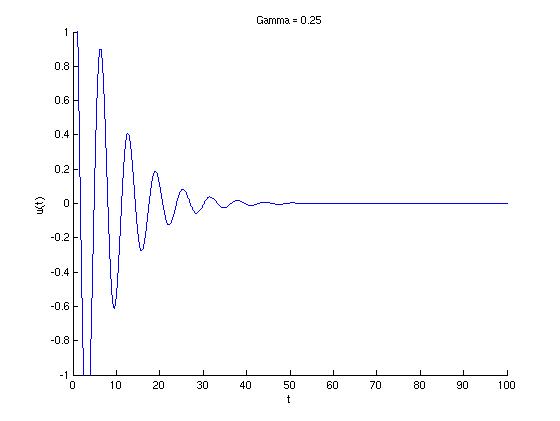
We want to find the value of  so that
-0.01 < u(t) < 0.01 for all t >
so that
-0.01 < u(t) < 0.01 for all t >  .
That is, we want to find the smallest value of t so that u(t)
is between the aqua lines shown on the graph below from that point onward. These commands will add to the graph created above.
.
That is, we want to find the smallest value of t so that u(t)
is between the aqua lines shown on the graph below from that point onward. These commands will add to the graph created above.
>> tolerance=0.01;
z=inline(sprintf('%g',tolerance),'t'); % Define the function z = 0.01
negz=inline(sprintf('%g',tolerance),'t'); % Define the function negz = -0.01
fplot(z,[tmin,tmax],'c'); % Plot the horizontal line y = 0.01
fplot(negz,[tmin,tmax],'c'); % Plot the horizontal line y = -0.01
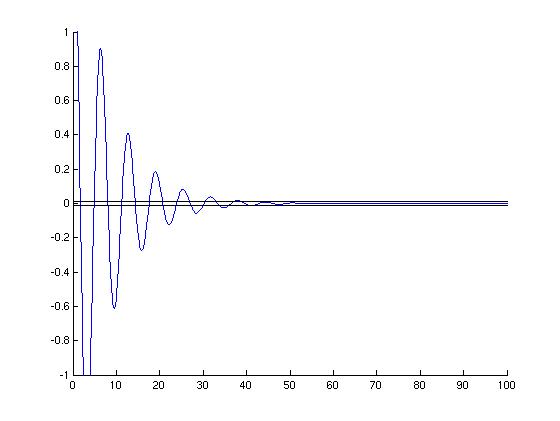
Instead of looking for the value of t for which all y-values beyond that point are between -0.01 and 0.01, let's look backwards from the right side of the graph back to the left. When is the first time the graph of the solution crosses either one of the horizontal aqua lines going from right to left?
>> num=size(ypts,2); % How many points did we have?
for i=1:num
j=num+1-i; % Count backwards
if abs(ypts(j))>tolerance % if outside of the aqua lines, notify user
disp(sprintf('\nFor all t > %g, -%g < y < %g',tpts(j), tolerance, tolerance));
break % Exit loop when we find the first y-value outside of the aqua band
end
end
plot(tpts(j),ypts(j),'rp') % Add a red star
plot(tpts(j:num),ypts(j:num),'r') % Re-draw the end of the curve in red
For all t > 41.715, -0.01 < y < 0.01
>>
Thus, when  ,
,  = 41.7417.
= 41.7417.
Note: This is only an approximation and not an exact value for  .
If we were to increase the number of points in the arrays 'tpts' and 'ypts' (back in
the 'tpts=(tmin:0.001:tmax)' command, we'd get
a more precise answer for
.
If we were to increase the number of points in the arrays 'tpts' and 'ypts' (back in
the 'tpts=(tmin:0.001:tmax)' command, we'd get
a more precise answer for  . However, we'd also greatly
increase the computation time.
. However, we'd also greatly
increase the computation time.
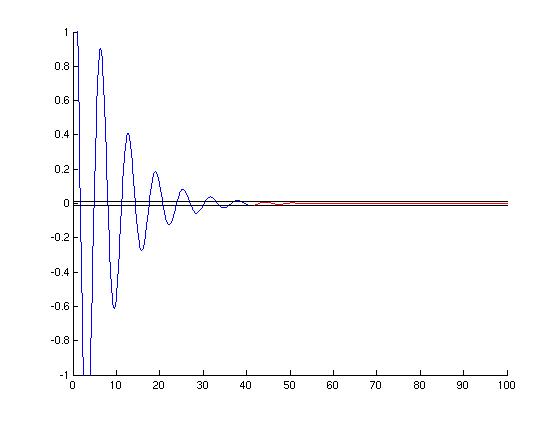
The MATLAB module Ch03Sec08Prob25 will
find the value of  for a user-entered value of
for a user-entered value of
 , and allow the user to create the final graph above
if desired. This module was used to obtain the data below and in part (d).
, and allow the user to create the final graph above
if desired. This module was used to obtain the data below and in part (d).
If we repeat the above process for values of  between
0 and 1.5, we get the values for
between
0 and 1.5, we get the values for  in the table below:
in the table below:
 |
 |
|---|---|
| 0.1 | 104.262 |
| 0.2 | 51.208 |
| 0.25 | 41.715 |
| 0.3 | 35.288 |
| 0.4 | 26.237 |
| 0.5 | 20.402 |
| 0.6 | 17.336 |
| 0.7 | 14.548 |
| 0.8 | 11.845 |
| 0.9 | 11.682 |
| 1.0 | 9.168 |
| 1.1 | 9.226 |
| 1.2 | 9.097 |
| 1.3 | 6.729 |
| 1.4 | 6.989 |
The points from part (b) are plotted in the graph below:
>> xx=[.1 .2 .25 .3 .4 .5 .6 .7 .8 .9 1 1.1 1.2 1.3 1.4]
>> yy=[104.262 51.208 41.715 35.288 26.237 20.402 17.336 14.548 11.845 11.682 9.168 9.226 9.097 6.729 6.989];
>> figure
>> plot(xx,yy,'bs') % Plot blue squares this time
>> xlabel('Gamma');
>> ylabel('Tau');
>> title('Tau -vs- Gamma');
>>
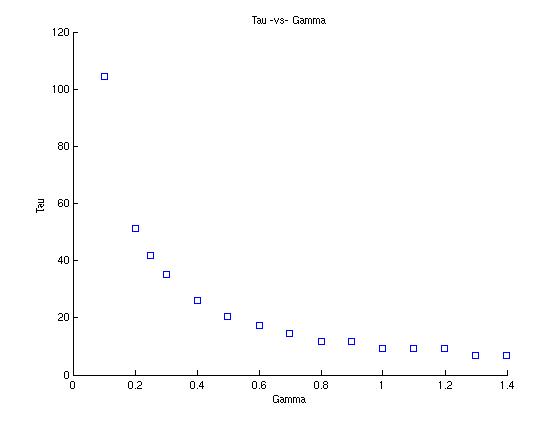
The values appear to decay exponentially, but if we look closely, the numbers do not always decrease.
Here is a table of values for  between 1.5 and 2 and
the corresponding plot:
between 1.5 and 2 and
the corresponding plot:
 |
 |
|---|---|
| 1.55 | 7.230 |
| 1.60 | 7.218 |
| 1.65 | 7.108 |
| 1.70 | 6.767 |
| 1.75 | 5.033 |
| 1.80 | 5.472 |
| 1.85 | 5.956 |
| 1.90 | 6.459 |
| 1.95 | 6.956 |
As we can see in the graph below, there is a definite dip in the values
of  near 1.75.
near 1.75.
>> xx2=[1.55 1.6 1.65 1.7 1.75 1.8 1.85 1.9 1.95];
>> yy2=[7.23 7.218 7.108 6.767 5.033 5.472 5.956 6.459 6.956];
>> plot(xx2,yy2,'bp');
>> xlabel('Gamma');
>> ylabel('Tau');
>> title('Tau -vs- Gamma');
>>
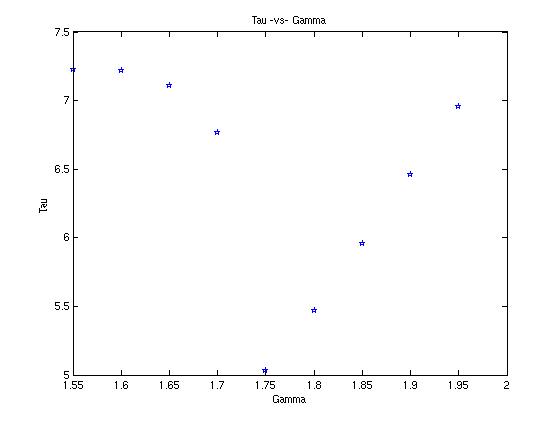
Now, let's investigate further to find out which value of
 produces the lowest value of
produces the lowest value of  . It appears to be between 1.7 and 1.8. Further experimentation gives us the following table:
. It appears to be between 1.7 and 1.8. Further experimentation gives us the following table:
 |
 |
|---|---|
| 1.71 | 6.612 |
| 1.72 | 6.245 |
| 1.73 | 4.873 |
| 1.74 | 4.952 |
| 1.75 | 5.033 |
| 1.76 | 5.117 |
| 1.77 | 5.202 |
| 1.78 | 5.290 |
| 1.79 | 5.380 |
Thus, to two decimal places, the lowest value of  is 4.873 when
is 4.873 when  is 1.73.
is 1.73.
The form of the solution to the initial value problem is
![]() ,
,
where ![]() are the roots of
the characteristic equation. Using
the quadratic formula, we find that
are the roots of
the characteristic equation. Using
the quadratic formula, we find that ![]() and
and ![]() .
.
As functions of g, the
coefficients A and B are found to be ![]() and
and ![]() . If we
write u(t) in the form (26), we
have
. If we
write u(t) in the form (26), we
have
![]() ,
,
where ![]() and
and ![]() . Using trigonometry,
we find that
. Using trigonometry,
we find that ![]() and subsequently
and subsequently
![]() .
.
If we ignore the cosine factor, we get the envelope function
![]() . A graph of
this function together with the actual solution u(t) is shown below for
. A graph of
this function together with the actual solution u(t) is shown below for ![]() .
.
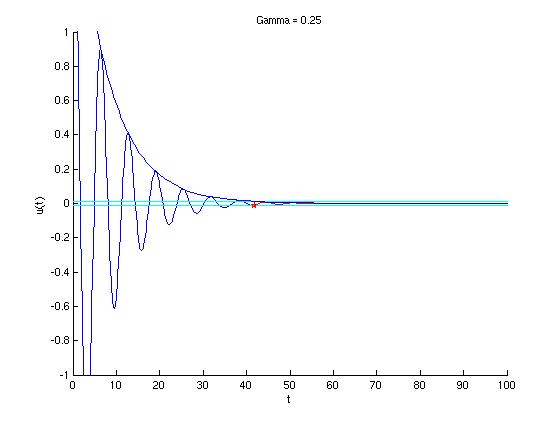
We can see from the graph that -0.1 < u(t) < 0.1 wherever U(t) < 0.1. So, let's see where that happens. For simplicity, we will again write the amplitude as R. First, we need to solve

Solving for  , we have
, we have

Now, we have  as a function of
as a function of  .
Let's use MATLAB to compare values from this function to our previously found
values of
.
Let's use MATLAB to compare values from this function to our previously found
values of  .
.
>> gamma=[.1 .2 .25 .3 .4 .5 .6 .7 .8 .9 1.0 1.1 1.2 1.3 1.4 1.55 1.6 1.65 1.7 1.75 1.8 1.85 1.9 1.95];
>> T=inline('(2./g).*log(400./sqrt(4-g.*g))','g'); % define tau function
>> tau=feval(T,gamma) % evaluate tau's
tau =
Columns 1 through 9
105.9914 53.0334 42.4495 35.3980 26.5936 21.3223 17.8182 15.3247 13.4637
Columns 10 through 18
12.0255 10.8843 9.9608 9.2024 8.5736 8.0500 7.4287 7.2614 7.1140
Columns 19 through 24
6.9874 6.8843 6.8096 6.7740 6.8024 6.9769
>>
Below is a table that compares the values of  using the graphical approximation method and the algebraic approach above.
using the graphical approximation method and the algebraic approach above.
 |
Approx.  from (b) and (d) |
Approx.  from (e) |
|---|---|---|
| 0.1 | 104.262 | 105.9914 |
| 0.2 | 51.208 | 53.0334 |
| 0.25 | 41.715 | 42.4495 |
| 0.3 | 35.288 | 35.3980 |
| 0.4 | 26.237 | 26.5936 |
| 0.5 | 20.402 | 21.3223 |
| 0.6 | 17.336 | 17.8182 |
| 0.7 | 14.548 | 15.3247 |
| 0.8 | 11.845 | 13.4637 |
| 0.9 | 11.682 | 12.0255 |
| 1.0 | 9.168 | 10.8843 |
| 1.1 | 9.226 | 9.9608 |
| 1.2 | 9.097 | 9.2024 |
| 1.3 | 6.729 | 8.5736 |
| 1.4 | 6.989 | 8.0500 |
| 1.55 | 7.230 | 7.4287 |
| 1.60 | 7.218 | 7.2614 |
| 1.65 | 7.108 | 7.1140 |
| 1.70 | 6.767 | 6.9874 |
| 1.75 | 5.033 | 6.8843 |
| 1.80 | 5.472 | 6.8096 |
| 1.85 | 5.956 | 6.7740 |
| 1.90 | 6.459 | 6.8024 |
| 1.95 | 6.956 | 6.9769 |
The reason for the difference between the two approximations for
 is that we ignored the cosine term in part (e). Thus, the two columns should not be exactly alike. However, since the
exponential function used in part (e) is always greater than the actual function used in the rest of the problem, we should expect that the values in the second column are always greater than (or equal to) those in the first, which is
the case.
is that we ignored the cosine term in part (e). Thus, the two columns should not be exactly alike. However, since the
exponential function used in part (e) is always greater than the actual function used in the rest of the problem, we should expect that the values in the second column are always greater than (or equal to) those in the first, which is
the case.
Comments: In part (c), we noticed that the graph of
 versus
versus  appeared to decay
exponentially. In part (e), we have found that the equation of this function
is not an exponential function, but is instead a more complicated
logarithmic function.
appeared to decay
exponentially. In part (e), we have found that the equation of this function
is not an exponential function, but is instead a more complicated
logarithmic function.